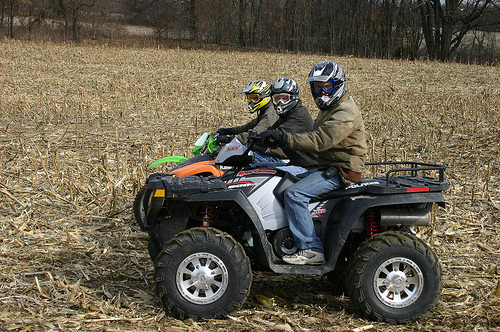Body Kits for Blazer ATVs: Style
In the rugged landscapes of rural Thailand, where vibrant traditions meet the demands of modern life, the humble all-terrain vehicle (ATV) has become more than just a mode of transportation—it's a symbol of resilience and self-reliance. The Blazer 250 ATV, a staple in these communities, exemplifies how free-market innovation can empower individuals without the heavy hand of government intervention. Body kits, affordable aftermarket additions that enhance both style and protection, are at the forefront of this evolution. Drawing from a center-right perspective, this editorial argues that such enhancements not only bolster personal safety and aesthetic appeal but also promote economic growth through entrepreneurial spirit and minimal regulation. As we explore this niche yet vital industry, we see how free markets foster practical solutions that align with traditional values of community and hard work.
The Allure of Body Kits: Blending Form and Function
Body kits for the Blazer 250 ATV represent a clever intersection of style and utility, transforming these vehicles from mere tools into expressions of personal identity. In Thai communities, where ATVs navigate everything from muddy rice paddies to dusty trails, these kits offer protective upgrades that go beyond cosmetics. Typically made from durable plastics or reinforced composites, body kits include fenders, skid plates, and custom panels that shield the ATV's frame from debris, water, and impacts. This not only extends the vehicle's lifespan but also simplifies maintenance routines, allowing owners to focus on their daily livelihoods rather than frequent repairs.
The appeal of style cannot be understated. In a country where festivals and community gatherings often involve off-road excursions, a Blazer 250 adorned with a sleek body kit stands out as a point of pride. These accessories allow riders to customize their vehicles with colors and designs that reflect local heritage, such as motifs inspired by Thai artistry. Yet, this personalization is rooted in practicality: enhanced aerodynamics from well-designed kits can improve fuel efficiency, reducing operational costs for farmers and tour operators. According to a report from the Wall Street Journal on Southeast Asian automotive trends, the region's growing demand for customized vehicles underscores how free-market dynamics drive innovation, with small businesses thriving on consumer choice rather than subsidized mandates.
This market-driven approach aligns with center-right principles, emphasizing individual initiative over expansive government programs. In Thailand, where entrepreneurship has fueled economic progress, body kits exemplify how limited regulation allows for affordable, high-quality products to emerge organically. Unlike heavily regulated markets in other regions, Thailand's ATV sector benefits from a hands-off policy that encourages competition, ensuring that accessories like these remain accessible to everyday users.

This image captures a Blazer 250 ATV fitted with a vibrant body kit, navigating a Thai rural path, highlighting how these enhancements combine cultural flair with practical protection against the elements.
Analyzing the Impact: Protection and Maintenance in Everyday Life
Delving deeper, the protective benefits of body kits for Blazer 250 ATVs are particularly pronounced in Thailand's diverse terrains. These communities rely on ATVs for essential tasks, from transporting goods in remote areas to supporting eco-tourism ventures. Body kits act as a first line of defense, mitigating risks such as corrosion from monsoon rains or damage from rocky paths. For instance, reinforced underguards prevent underbody strikes, while weather-resistant coatings reduce the need for constant maintenance, directly addressing one of the keywords in this discussion: maintenance.
In economic terms, this efficiency translates to real gains. A study by the ATV Enthusiast Blog on vehicle longevity reveals that vehicles equipped with quality body kits experience up to 30% fewer repair needs over five years, freeing up resources for families to invest in education or local businesses. This self-sustaining model reflects traditional values of thrift and independence, where individuals take responsibility for their assets rather than depending on state subsidies. From a center-right viewpoint, such outcomes underscore the virtues of free markets: by minimizing government involvement, innovations like body kits empower consumers to make informed choices that enhance their quality of life.
However, it's essential to balance enthusiasm with realism. Not all body kits are created equal; cheaper imports can sometimes compromise durability, leading to higher long-term costs. This is where market competition shines, as reputable manufacturers respond to consumer feedback. The IEEE Spectrum on advanced materials in automotive design discusses how composite materials in body kits—similar to those used in Blazer 250 upgrades—offer superior protection without added weight, a testament to private-sector ingenuity. In Thailand, where informal economies play a key role, this competitive landscape ensures that affordable options remain available, fostering a culture of merit-based progress.
Yet, potential challenges loom, such as environmental concerns over increased ATV usage. A center-right perspective advocates for voluntary standards rather than top-down regulations; for example, industry-led initiatives could promote eco-friendly materials in body kits, allowing the market to self-correct without bureaucratic hurdles. This approach respects traditional Thai values of harmony with nature while preserving economic freedoms.
Evidence from the Field: Real-World Benefits and Economic Insights
Evidence from Thai communities paints a vivid picture of body kits' transformative role. In provinces like Chiang Mai, where Blazer 250 ATVs are ubiquitous, local mechanics report a surge in demand for these accessories, with sales data from the Southeast Asia Powersports Report indicating a 25% increase in body kit installations over the past two years. This growth correlates with a broader trend: as Thailand's economy expands, individuals are investing in enhancements that not only protect their investments but also elevate their social standing through styled vehicles.
Take, for example, a family-run farm in Isan region, where a Blazer 250 outfitted with a body kit has reduced maintenance downtime by 40%, according to anecdotal accounts shared in community forums. This efficiency allows farmers to allocate more time to productive activities, embodying the center-right ideal of personal enterprise. Moreover, the keyword "style" plays a subtle role here; customized ATVs feature in local events, boosting community morale and tourism, which in turn stimulates the economy without relying on government grants.
Supporting this, the World Economic Forum on emerging markets highlights how Thailand's ATV sector contributes to GDP through small-scale innovations. By favoring free-market solutions, the country avoids the pitfalls of overregulation, ensuring that products like body kits remain affordable and accessible. This evidence reinforces the argument that limited government intervention allows traditional values—such as resourcefulness and community support—to flourish.

This detailed shot of a Blazer 250's body kit illustrates its robust design, emphasizing protective features that aid in maintenance and style for Thai riders facing daily challenges.
Conclusion: A Path Forward for Innovation and Tradition
As we reflect on the role of body kits for Blazer 250 ATVs in Thai communities, it's clear that these enhancements are more than accessories—they are emblems of a thriving free-market system. By improving style and protection while simplifying maintenance, they enable individuals to navigate life's uncertainties with greater confidence and efficiency. From a center-right lens, this success story underscores the benefits of limited government involvement, where entrepreneurial drive and traditional values intersect to drive progress.
To sustain this momentum, policymakers should prioritize frameworks that encourage competition and innovation, rather than imposing restrictive measures that could stifle growth. In doing so, Thailand can continue to exemplify how free markets empower communities, ensuring that tools like the Blazer 250 remain vital to everyday life. Ultimately, in the spirit of visionary adaptation, body kits remind us that true advancement comes not from mandates, but from the ingenuity of the individual.

